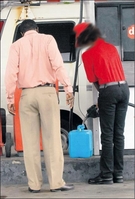How does the BSJ protect you at the gas pumps?
Published: Sunday | May 3, 2009

Gleaner reporter Tyrone Reid (left) purchases petrol during a test of gas station pumps. - Ian Allen/Staff Photographer
THE EQUIPMENT used to test the accuracy of gas station pumps include working standards, testing and stamping equipment. The provers (working standards) are measuring devices, which have been calibrated and are traceable to the national standards.
Officers dispense fuel from the nozzle into these provers of 20-litre and 5-litre volume capacity. The test measure is then checked to verify if the gas pumps have over- or under-delivered.
Should the indicated volume on the test measure/prover be outside the stipulated allowable tolerance, a 'Rejected' sticker is affixed to the pump. The gas pump is also padlocked. The gas pump should not be used unless calibrated and reverified by officers of the Bureau of Standards.
Repairs
Repairs to the pump must be carried out in the presence of the officers of the Bureau of Standards. During the period of testing and certification, technicians of the marketing companies are on hand to make adjustments or repairs if necessary.
Random tests are carried out by officers of the Bureau of Standards in fulfilling its mandate. Additionally, companies that subscribe to the voluntary Gas Pump Certification Programme are to be tested at least twice per year.
Wear and tear over time may affect accuracy in the delivery of fuel. Technicians with marketing companies carry out necessary repairs and adjustments to correct any fault with the gas pumps.
- Courtesy of the Bureau of Standards Jamaica










